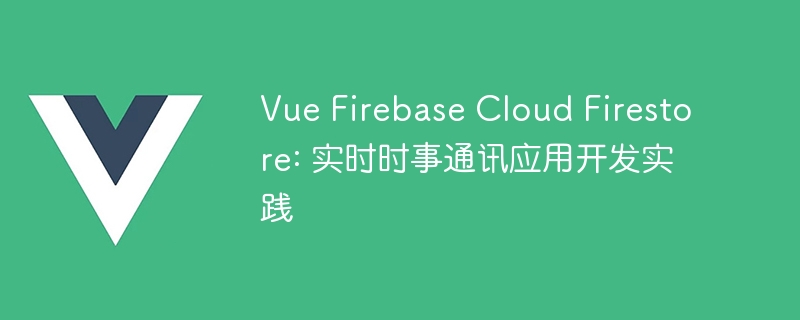

Vue Firebase Cloud Firestore: Real-time newsletter application development practice
In recent years, with the rapid development of the mobile Internet, people's demand for real-time communication applications is increasing. Real-time newsletter applications allow users to interact and communicate with other users while getting the latest information. This article will introduce how to develop a real-time newsletter application using Vue.js and Firebase Cloud Firestore, and provide specific code examples.
# 安装Vue CLI npm install -g @vue/cli # 创建新项目 vue create realtime-news-app
After the installation is complete, use the cd command to enter the project directory and run npm run serveCommand to start the project:
cd realtime-news-app npm run serve
Select "Start Mode" as "Test Mode" and then select the location that belongs to your project; next, select Enable. Afterwards you will see that a Cloud Firestore database is successfully created.
Click the "Settings" button and select "Project Settings". In the pop-up dialog box, find the "Add App" button and click it. Select "Add Web App" and give it a name. Once completed, you will be provided with a set of configuration information, including the provided API key and project ID.
Return to the root directory of the project and execute the following command on the command line to install the Firebase library:
npm install firebase
Create a new Firebase configuration file (for example src/firebaseConfig.js), and copy the configuration information of the Firebase project into this file:
// src/firebaseConfig.js
export default {
apiKey: "your_api_key",
authDomain: "your_auth_domain",
projectId: "your_project_id",
storageBucket: "your_storage_bucket",
messagingSenderId: "your_messaging_sender_id",
appId: "your_app_id",
}; In your main Vue component file (such as src/App.vue), import this configuration file , and initialize Firebase:
// src/App.vue import firebase from "firebase"; import firebaseConfig from "./firebaseConfig"; firebase.initializeApp(firebaseConfig);
Create a collection called news in Firebase and create a document for each news. The fields contained in the document are as follows:
title: News title content: News content timestamp: Publish timestampIn the Vue component, we can use the API provided by Firestore to read and write data. The following is an example method for publishing news:
// src/App.vue
async publishNews() {
const newsRef = firebase.firestore().collection("news");
const timestamp = firebase.firestore.FieldValue.serverTimestamp(); // 获取当前时间戳
try {
await newsRef.add({
title: this.title,
content: this.content,
timestamp
});
this.title = "";
this.content = "";
console.log("发布成功!");
} catch (error) {
console.error("发布失败!", error);
}
}To subscribe to news, we can use the onSnapshot method to listen for changes in the collection and update the view in time. The following is an example method for subscribing to news:
// src/App.vue
subscribeToNews() {
const newsRef = firebase.firestore().collection("news");
newsRef.onSnapshot((snapshot) => {
const news = snapshot.docs.map((doc) => doc.data());
this.news = news;
});
}In the created life cycle hook function of the Vue component, we can call the subscribeToNews method and start subscribing to news:
// src/App.vue
created() {
this.subscribeToNews();
}Through the above practices, we have successfully developed a real-time newsletter application using Vue.js and Firebase Cloud Firestore. Users can publish news and other users can subscribe to the news and receive the latest content in real time. I hope this article will help you understand and practice real-time communication applications.
Summary
This article describes the steps to develop a real-time newsletter application using Vue.js and Firebase Cloud Firestore, and provides specific code examples. By combining these two powerful tools, we can quickly build efficient, real-time communication applications. We hope these examples are helpful in your development efforts and help you build feature-rich real-time messaging applications.
The above is the detailed content of Vue Firebase Cloud Firestore: Real-time newsletter application development practices. For more information, please follow other related articles on the PHP Chinese website!